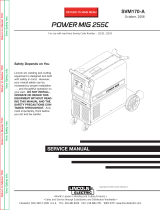
Water Level Meter Battery Drawer Replacement
Solinst Canada Ltd. 35 Todd Road, Georgetown, Ontario Canada L7G 4R8 www.solinst.com
E-mail: instruments@solinst.com Tel: +1 (905) 873-2255; (800) 661-2023 Fax: +1 (905) 873-1992
February 15, 2022
(#106974)
Tools and Materials Needed
1. Replacement Battery Drawer Assembly (#103559), includes:
• Single 9 Volt Battery Tray/Drawer (#103308)
• 2 x #4 x 1/2" Phillips Screws (#101712) for plastic reels
• 2 x #4-40 x 1/2" Phillips Bolts (#100103)
and 2 x #4-40 Nuts #102154) for metal reels
2. Phillips Screwdriver
3. #4-40 Wrench (for metal reels)
4. Wire Cutters and Strippers (if required)
5. Soldering Wire and Iron (if required)
Note: To remove the battery drawer, press the drawer in, lift then pull.
The battery drawer should slide out of the faceplate enough to
pull it out and remove.
Instructions
1. Remove the battery drawer from the faceplate.
2. Undo the three screws from the front of the faceplate and
remove the faceplate from the reel.
3. For Meters with a Molex connection, undo the connector
that connects the faceplate electronics to the tape.
4. For Meters with the tape leads connected to the circuit
board, press down on the white terminals of the push-
release fittings and pull to remove the tape/cable leads.
Note how they are connected.
5. For the Meters with a Molex connection, cut the red and
black wires from the back of the battery tray close to the
terminals.
Battery Tray Positive
Negative
Battery Drawer
#4 x 1/2"
Phillips Screws
(for plastic reels)
#4-40 x 1/2"
Phillips Bolts and Nuts
(for metal reels)
11. Note the polarity and place the battery in the new battery
drawer. The positive terminal of the battery is placed
towards the small notch in the end of the drawer.
12. Slide the battery drawer into the battery tray in the
faceplate.
13. If applicable, reconnect the Molex connector from the
faceplate electronics to the tape.
14. If applicable, press down on the white terminals on the
circuit board and insert the tape/cable leads. Release the
terminals and the leads should be secured.
For the Mk3 107 and 201, the lead on the top of the
tape is inserted into the terminal labelled TOP on the circuit
board.
For the Mk2 101, 101D, and 105, the lead on the top
of the tape (top of numbers or see note below) is inserted
into the terminal with a white square below it on the circuit
board.
Note: Model 122 P8 Interface Meters have two black wires connected
to the battery tray.
6. For the Meters where tape leads were connected to the
circuit board, simply pull to remove the red and black wires
from the terminals on the battery tray.
7. Undo the two screws (and nuts for metal reels) holding the
battery tray in the faceplate. Remove the old battery tray.
8. Place the new battery tray through the faceplate and secure
it with the two screws (and nuts where required).
9. For the Meters with a Molex connection, strip the red
and black wires, cut from the old battery tray, about 1/4"
(6 mm). Solder the black wire(s) to the negative terminal on
the battery tray, and the red wire to the positive terminal.
The terminals are labeled on the tray.
Note: For Model 122 P8 Interface Meters, solder the black wire with
brown resistor, to the positive terminal on the battery tray.
(9V Battery
Not Included)
For the Model Mk2 102, the negative lead is inserted into
the terminal with a white square below it on the circuit
board. The negative pin is connected to the black insulated
braided wire.
15. Test that the Meter is working correctly. Refer to the
Operating Instructions, if required.
16. Use the three screws to replace the faceplate back on the
reel.
10. For the Meters where tape leads were connected to the
circuit board use the quick-connect fittings on the red
and black wires to connect the black wire to the negative
terminal on the battery tray, and the red wire to the positive
terminal. The terminals are labeled on the tray.
Note: There is a “P” etched on the tape to help denote the proper
orientation of the tape – top and bottom leads.
Top
Bottom
“P”
More Info | Instructions | Get Quote









